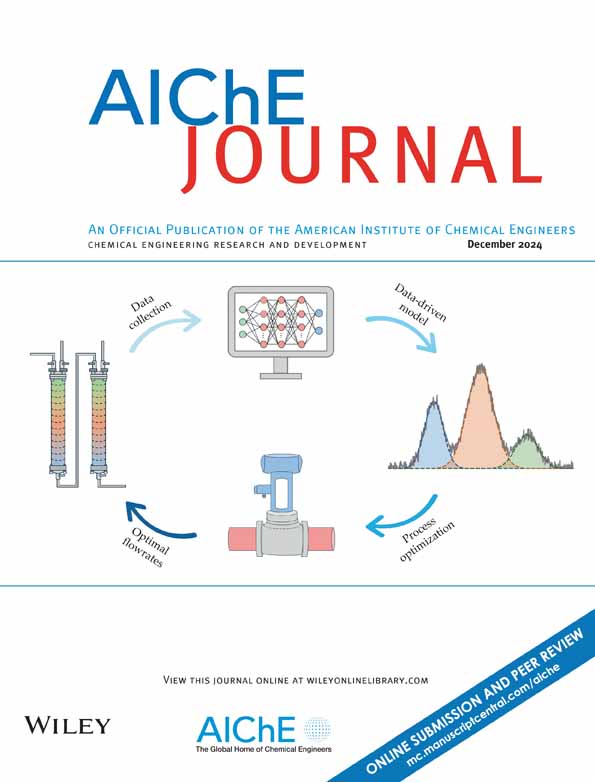Confined dual-interface HRGO/Cu2O@CuMOF heterojunction for enhanced photothermal methanol/water reforming to hydrogen
IF 4
3区 工程技术
Q2 ENGINEERING, CHEMICAL
引用次数: 0
Abstract
Photothermal-driven methanol/water reforming offers as a sustainable route for low-temperature, on-site hydrogen (H2) production by coupling solar energy with liquid fuel compatibility. Herein, a HRGO/Cu2O@CuMOF core-shell heterojunction catalyst was in situ constructed via a homologous coordination etching strategy. This design introduces dual-interface synergy and confined spatial architecture: HRGO-Cu+ interface enhances water adsorption and activation, accelerating OH· radical generation for C–H bond cleavage in methanol; Cu2O-CuMOF junction facilitates charge separation and stepwise dehydrogenation through spatially confined intermediate transformation. Benefiting from this cooperative architecture, the catalyst achieves a high H2 production rate of 77.2 mmol gcat−1 h−1 at 210°C, nearly 8 times of thermal reforming, with activation energy significantly reduced by 29.6%. Notably, the catalyst can initiate H2 generation as low as 100°C, and maintains excellent activity and integrity over 72 h. This work offers a scalable strategy for constructing MOF-based heterojunctions with confined interface synergy, advancing sustainable photothermal H2 production.受限双界面HRGO/Cu2O@CuMOF异质结增强光热甲醇/水重整制氢
光热驱动的甲醇/水重整通过将太阳能与液体燃料兼容性相结合,为低温现场制氢提供了一条可持续的途径。本文通过同源配位蚀刻策略原位构建了HRGO/Cu2O@CuMOF核壳异质结催化剂。本设计引入双界面协同和密闭空间结构:HRGO-Cu+界面增强水吸附和活化,加速OH·自由基生成,促进甲醇中C-H键的裂解;Cu2O-CuMOF结通过空间受限的中间转化促进电荷分离和逐步脱氢。得益于这种协同结构,该催化剂在210℃下的产氢率达到77.2 mmol gcat−1 h−1,是热重整的近8倍,活化能显著降低29.6%。值得注意的是,该催化剂可以在低至100°C时生成H2,并在72 h内保持良好的活性和完整性。这项工作提供了一种可扩展的策略来构建基于mof的异质结,具有有限的界面协同作用,促进可持续的光热制氢。
本文章由计算机程序翻译,如有差异,请以英文原文为准。
求助全文
约1分钟内获得全文
求助全文
来源期刊

AIChE Journal
工程技术-工程:化工
CiteScore
7.10
自引率
10.80%
发文量
411
审稿时长
3.6 months
期刊介绍:
The AIChE Journal is the premier research monthly in chemical engineering and related fields. This peer-reviewed and broad-based journal reports on the most important and latest technological advances in core areas of chemical engineering as well as in other relevant engineering disciplines. To keep abreast with the progressive outlook of the profession, the Journal has been expanding the scope of its editorial contents to include such fast developing areas as biotechnology, electrochemical engineering, and environmental engineering.
The AIChE Journal is indeed the global communications vehicle for the world-renowned researchers to exchange top-notch research findings with one another. Subscribing to the AIChE Journal is like having immediate access to nine topical journals in the field.
Articles are categorized according to the following topical areas:
Biomolecular Engineering, Bioengineering, Biochemicals, Biofuels, and Food
Inorganic Materials: Synthesis and Processing
Particle Technology and Fluidization
Process Systems Engineering
Reaction Engineering, Kinetics and Catalysis
Separations: Materials, Devices and Processes
Soft Materials: Synthesis, Processing and Products
Thermodynamics and Molecular-Scale Phenomena
Transport Phenomena and Fluid Mechanics.
 求助内容:
求助内容: 应助结果提醒方式:
应助结果提醒方式:


